Open Data will create more than 100,000 jobs

With the emergence in Europe of smart cities and data-driven innovation centres, their potential has become indisputable. In particular, the value of data collected by the public sector has gained in relevance and attention in recent years.
Open Data has served as a means of promoting closer policies across Europe and better participation of citizens in their country’s decision-making processes, as well as increasing the transparency of public spending.
Open Data has sustained the development of processes and activities in the context of smarter mobility and connected cities. In addition to enabling the monitoring function of civil society by collecting all data pertaining to public expenditures, property, salaries of public officials.
In short, Open Data has become a facilitator for innovation and knowledge in today’s world.
According to a study published by Capgmini, Europe’s maturity with respect to Open data can be divided into four relevant aspects: politics, portal, impact and quality. The findings emphasize the prominence of a few European countries that have timely understood the value that can be derived from Open Data and have taken strategic steps to capture and nurture this potential.
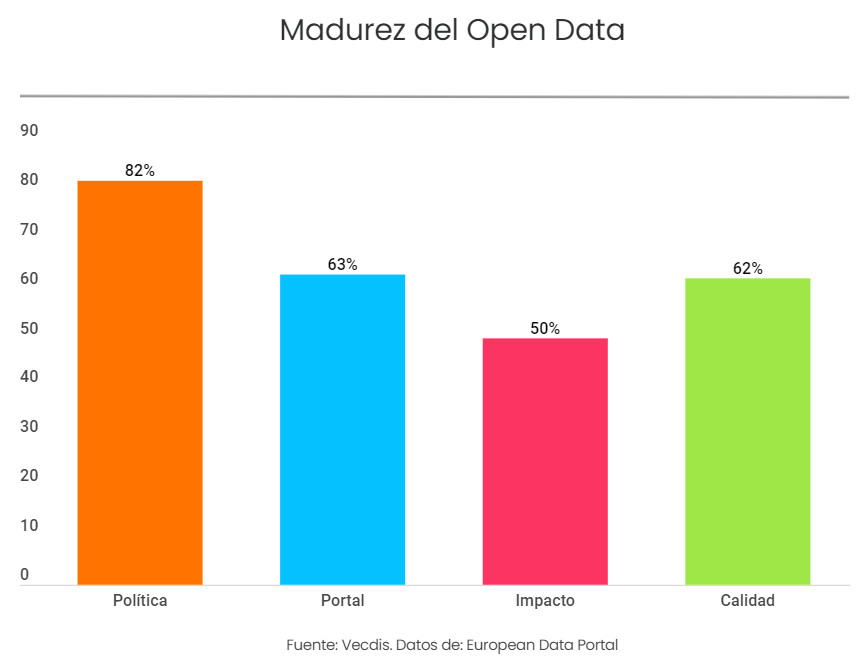
Open Data Policy
The dimension that Open Data policy can achieve focuses on nationally specific policies for managing data, existing licensing rules and the scope of coordination with respect to common guidelines and approaches to enable development across the country.
- Political framework:
The first indicator of this dimension focuses on Open Data’s national policies, and it is worth noting that all countries of the European Union except Sweden have a regulation dedicated to Open data, instead Sweden has a long tradition in terms of providing public access to official documents to its citizens.
- Coordination at the national level:
The second indicator analyses the existence of initiatives and guidelines at the national level that encourage the publication of Open Data in the country and the extent to which efforts are made at the national level to promote the development of local or regional initiatives in Open data field.
This indicator also explores efforts to enable data interoperability, as well as to drive publishing and reuse. It also assesses whether data publishing plans exist and whether progress against these plans was tracked.
An important benefit of integrating local or regional portals into national portals is improved visibility and discovery and then access to datasets published by the different administrations of a country.

The size of countries is also a critical element that determines the level of coordination. This is necessary at the central level, where countries such as Cyprus, Estonia, Latvia, Luxembourg, Malta and Slovenia, which are smaller and with less complex governance structures, may not need to be guaranteed regions and local levels. In most of these cases, the number of public bodies operating in the country is low and there are no other Open Data portals beyond the national.
With regard to the existence of a follow-up of public administrations that imposes them above the marginal costs of making them data are available for reuse, only 16 countries (Austria, Belgium, Croatia, Cyprus, Denmark, Estonia, Finland, France, Greece, Italy, Luxembourg, Netherlands, Slovakia, Slovenia and Sweden) have a mechanism installed in 2018.
- Regulations and licenses:
The third indicator refers to the extent to which guidelines are implemented to ensure that published data meet sits on the definition of “open” in both terms, be quota-free and most importantly, provide clear information on the terms and conditions under which the data can be reused, easing this uncertainty and encouraging its immediate reuse.
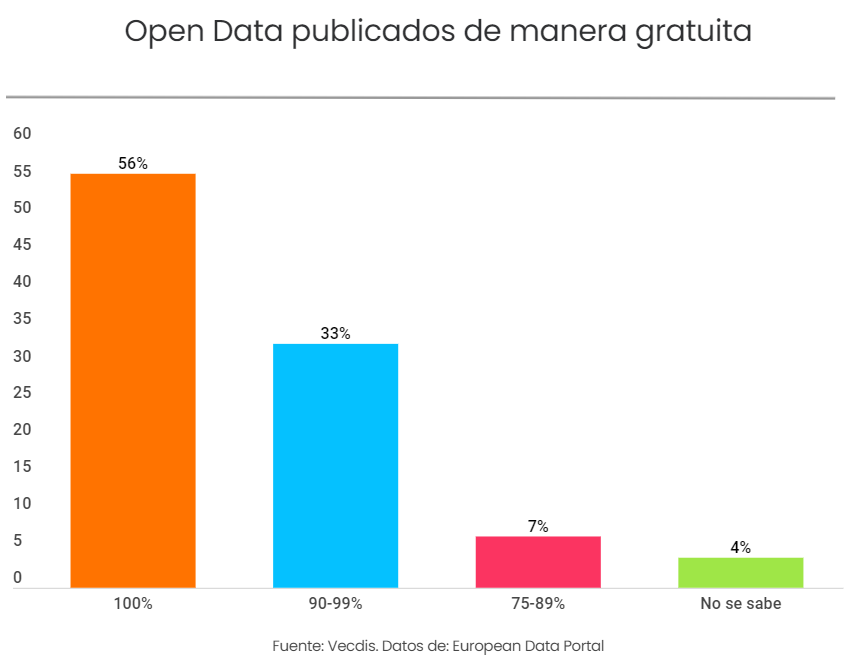
15 countries (56%) declared in 2018 that all their published data is freely accessible (Austria, Croatia, Cyprus, Czech Republic, Denmark Estonia, Finland, France, Italy, Latvia, Luxembourg, Netherlands, Poland, Portugal and Slovenia). In 9 other countries representing 33% (Belgium, Bulgaria, Greece, Ireland, Lithuania, Romania, Slovakia, Spain and Sweden) 90-99 of the data are accessible free of charge. And finally the United Kingdom and Germany where this percentage is slightly lower and ranges from 75% to 89%.
In terms of recommended licenses, while some member states have developed their own license terms (Germany, France, Romania or the United Kingdom), others promote the use of CC Suite licenses.
The Open Data portal
In 2018, 26 European countries have a national Open Data portal. Malta is currently in the process of developing a portal, as part of the Enterprise Data Management Strategy that is currently implemented in the country.
- Portal Features:
The first indicator analyzes the functionalities provided by open data national portals to users. It takes into account the standard and more advanced features of the portal.
The 26 national portals feature Advanced Search, a feature that allows visitors to search by data domain or file format. On the other hand, they all offer the possibility for users to download the linked datasets in the portal.
- Using the portal:
The second indicator in the “Portal” dimension refers to the portal usage metrics, such as the number of unique visitors, the percentage of foreign visitors, typical user profiles, more consulted datasets and popular data domains, traffic generated through the portal API, etc.
It also investigates the extent to which knowledge acquired through the analysis tools is used in the portal upgrade process. It is important to monitor these numbers to better understand portal users and their behavior when accessing the portal, as well as to obtain information about the general type of visitors that the portal attracts. It allows portal owners to verify design and features, as well as available data meet the needs of users.
In an ideal scenario, the analytical knowledge gained (e.g. API traffic, SPARQL queries made, number of visits to certain sections of the portal, and length of stay) can be used in decisions about what features should be included or potentially removed.
Throughout 2018, portal owners seem to have realized the importance of understanding their portal audience. While in 2017 only 39% of the portals used the analysis tool to obtain information, in 2018 the number doubled to 92%.

Going one step further, 20 of the 23 portal owners using analysis tools indicated that the knowledge gained also flow through the portal upgrade process (except Belgium, Croatia and Lithuania). This is an encouraging vision as it shows that portal owners have become more aware of the importance of understanding their audiences and trying to meet their needs.
In addition, there does not appear to be a correlation between a country’s maturity level (and implicitly the maturity of its Open Data ecosystem) and the percentage of traffic that occurs through the API. Only in France (3rd classified in 2018) you can see a positive correlation, with traffic generated through API reaching 65%.
Looking at the picture more broadly, the traffic generated through the API differs significantly across Europe, from 65% in France, to 28% in Cyprus and to 20% in the Netherlands. In Austria, Bulgaria and Luxembourg, the numbers only reach 10%, while in Spain (second place in 2018) API traffic represents only 1%.
It seems reasonable to assume that portal owners would want to better understand who and how their APIs are used through such records. In addition, when it comes to better capturing the use of a portal, it is also important to look at the number of unique visitors per month. In 2018 only Denmark, the Czech Republic and Portugal were unable to provide such statistics.
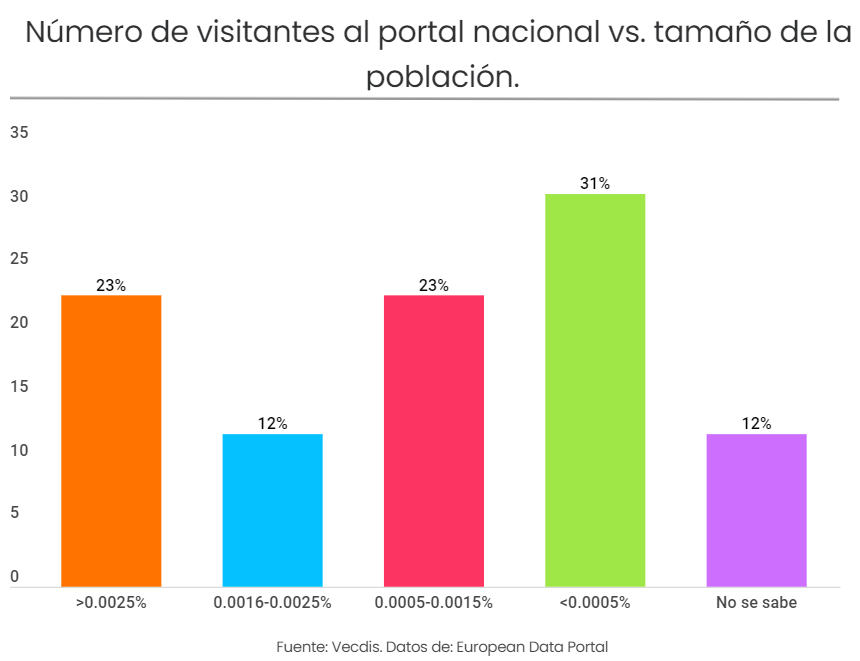
- Data provision
This indicator analyzes the variety of data available on the national portal reflected by the number of publishers, the data domains available, and the extent to which the portal also provides access to real-time and aggregated data by genre. The indicator also examines the popularity of available datasets and data domains, as well as the reasons behind the popularity of certain datasets.
As for the variety of data provided, the 2018 results are very good and show positive developments from previous years. As for data from the suppliers they publish on the national portal, the 26 portals examined provide data that comes from more than 10 different holders.
In 20 cases (77%), the portal owners were able to provide statistics on the 5 most consulted data. This represents an increase compared to 2017, when only 16 portal owners were able to provide such information.
In 2018, the most popular data domain was Government and Public Sector with 58% of the countries mentioning it in its top 5, followed by the Population and the Social Conditions, mentioned by 50% countries. Followed closely by data from the energy and environment sector.
- Portal Sustainability:
The fourth indicator in this dimension refers to the extent to which there is a strategy implemented to ensure the sustainability of the portal, the type of cost recovery model selected and the extent to which financing models were used alternatives for the national portal under consideration.
19 of the 26 portal owners (73%) state that such a strategy exists at the national level. However, this strategy seems to be limited to the mention of the portal in the Open Data Strategy. A separate strategy that sets out the necessary measures to ensure that the sustainability of the portal over time.
Looking at the funding model used, all existing national portals are based on funds unique to the state budget. In addition, only 4 portal owners indicated that alternative funding models were explored (Austria, the Czech Republic, Greece and Poland).
As for activities to improve the visibility and use of the portal, 17 of the 26 countries say they organize or attend events and conferences in which to promote the national portal. In addition, only 12 portal owners or administrators conducted a user satisfaction survey in the past year. 2 other portal owners indicated that they have plans to conduct that survey on their portal next year.
These numbers are quite modest and show that there is a lack of awareness and additional resources to allow such activities. In the light of the above and given the guaranteed funding provided by the State budget, the issue of sustainability does not appear to be among the priorities of portal owners across Europe.
Although European portal owners increasingly understand their portals as the main “nodes of interaction” between the supply and demand side of Open Data in their country, there is still significant scope to improve, for this, portal managers need to step up their efforts and catch up, in order to reflect this new mindset.
The impact of Open data
The goal of generating impact, whether political, economic or social, is the driver behind most Open Data initiatives. Demonstrate Impact helps create a virtuous circle for increased data publishing and reuse and also provides additional information so that public administrations are motivated to publish more data, as you can see first-hand the ways in which data can be transformed into value for citizens, businesses and society as a whole.
This also functions as a “business case” for public administration managers responsible for allocating resources (financial and human) to enable the publication of high-quality data.
- Political impact
In 2018, 14 EU Member States (52%) have carried out some kind of activity to monitor and show the political impact of Open Data on their country. This number has not changed from the 2017 figures.
For example, in Latvia, reports on the political impact are presented to the Information Society Council chaired by the Prime Minister. In Romania, surveys were conducted in the form of questionnaires and interviews to assess Open data knowledge, as well as the level of reuse of this data in public administrations. Similar activities were carried out in Bulgaria, where the national government conducted a series of case studies, interviews and surveys to assess the positive effects of data publication.
In Spain, periodic investigations are carried out through an online questionnaire on different public administrative entities, requesting them to identify the use cases in which they reuse this type of information.
In terms of efficiency and effectiveness, several Open data-based applications have been developed across Europe, with the aim of helping to streamline bureaucracy among citizens and government, promote self-management and free up resources within the public administrations.
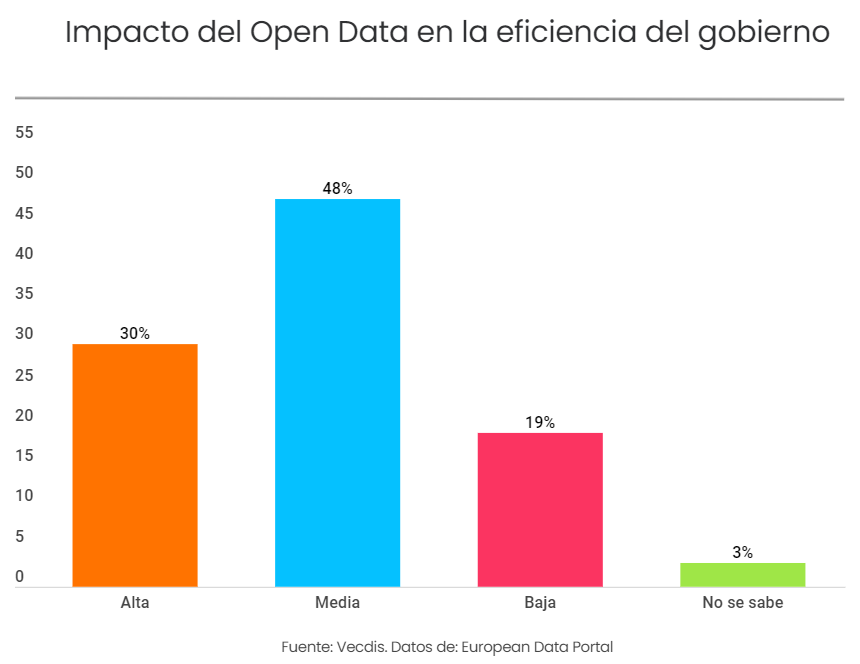
- Social impact
During this year only 11 Member States (41%) have carried out activities to monitor the social impact of Open Data. Some interesting examples of activities undertaken to promote the social impact of Open Data come from Ireland.
The Department of Education provides funding for a number of initiatives and projects aimed at identifying policy solutions for marginalized groups such as projects aimed at the integration and employment of migrants, and the promotion of equality gender.
Regarding the impact of Open Data on society at large, 11 countries consider that the adoption of strategies based on this type of data has had a high impact on the country’s society.
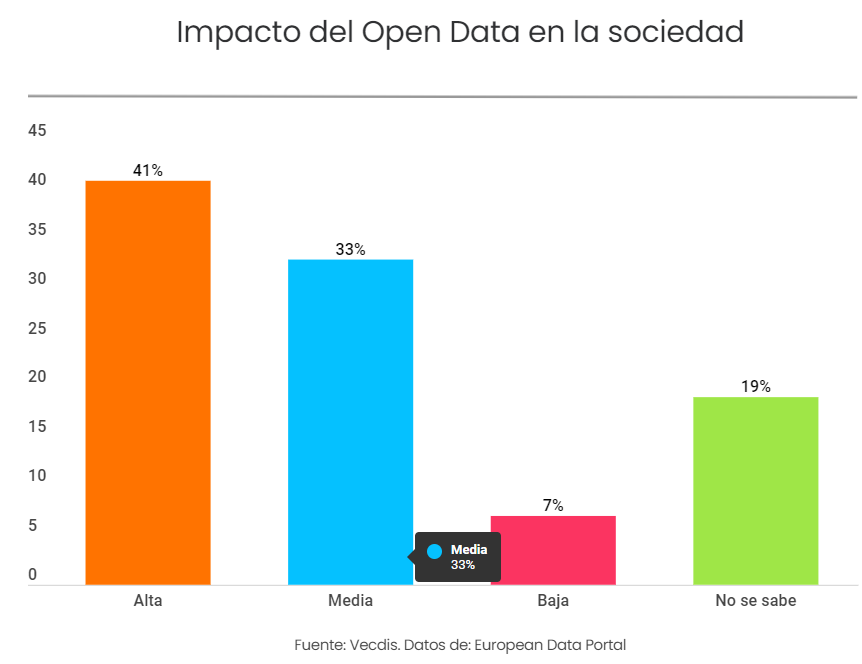
France is a good example to demonstrate how a good investment in an Open Data-based strategy can be huge. Through the “Data for Good” initiative, the community of data scientists, developers and volunteers who offer their digital skills to serve social projects.
Within this context, in early 2018 “Sherpa” was introduced a tool aimed at guiding a blind user to the nearest bus stop, specifying the destinations served and the calendar of future passes through a Bluetooth headset, thanks to all data pertaining to public transport.
- Environmental impact
In terms of activities to monitor Open Data’s environmental benefits, only 11 countries claimed to conduct such activities in 2018.
An example of this is Italy, a country in which the Ministry of Environment, Land and Sea has launched its own portal in 2018 by providing information on environmental assessments and authorizations granted to companies. In addition, to organize several forums and events at the municipal level to support the use of Open Data in the environmental field.
Despite the benefits it can set aside, when countries are asked to assess the impact of Open Data on the environment, 11 countries consider it to be high, 8 describe it as medium and 6 countries do not have sufficient evidence to assess the environmental impact from the use of Open Data.
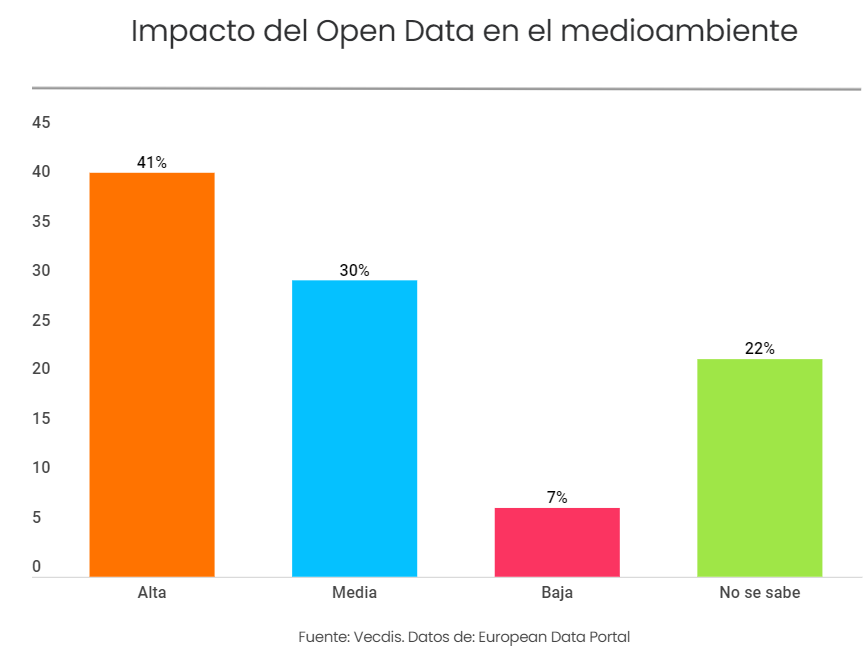
- Economic impact
Showing the economic impact of Open Data is essential to gather greater support to continue to create strategic based on this type of data. By 2020, the market size for Open Data is estimated to increase by 36.9% to a value of 75.7 billion euros, representing an annual growth of more than 8%, according to a study carried out by the European Data Portal.
The same study estimates that the number of jobs created through Open data projects will reach 100,000 by 2020. Around the 20% will be direct works by Open Data.
Open Data Quality
It is important to recognize where The quality of Open Data influences automation, reliability, and compliance in terms of the DCAT-AP metadata standard.
The automation indicator analyzes the availability and effectiveness of the approach used by countries to ensure that the metadata describing the available datasets is regularly updated.
In 2018, 77% of the national portals have stated that they have established a predefined approach to ensure the value of metadata and data itself.
Only Italy and Belgium declared that all metadata is automatically uploaded, in 5 other countries (Czech Republic, Germany, Netherlands, Spain and Sweden) more than 90% of the metadata upload is carried out automatically, while, in Ireland, Slovenia, France, Finland, that figure is between 70% and 79%. On the opposite side are Austria, Cyprus, Denmark, Estonia, Greece, Latvia, Lithuania, Poland, Romania and Slovakia which declare that less than 30 of the metadata is loaded automatically.
Conclusions
The results of 2018 are the best results that Europe has obtained in terms of open data maturity, as well as the best results in each of the four dimensions.
It highlights not only the different speeds at which Europe moves, but also the different focusiness in which each country has chosen to drive its Open Data transformation.
While the different levels of maturity and areas of focus of each country are taken into account, the results highlight a general urgency to ensure the publication of high-quality data to help drive reuse, as well as an urgent need to increase strategic awareness of the Impact generated by Open Data.


